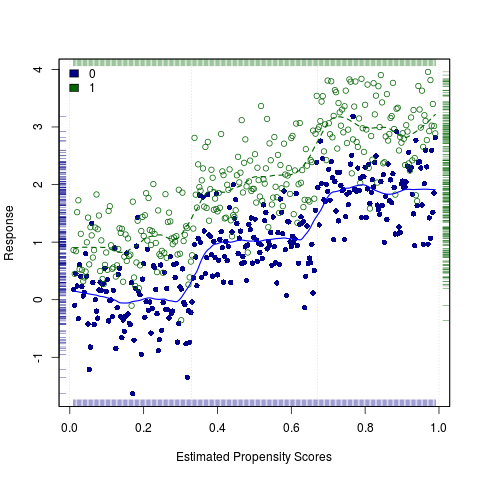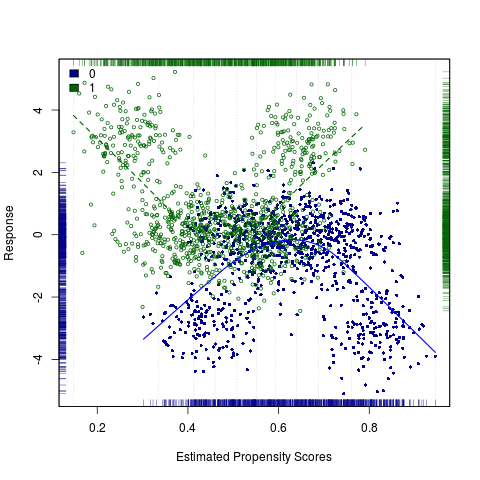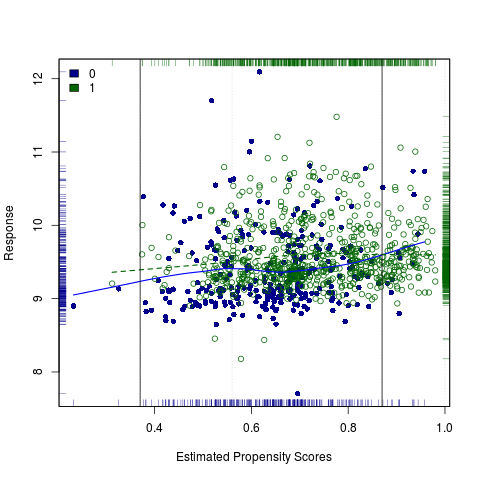Supported by Dr. Osamu Ogasawara and  providing providing  . . |
|
Last data update: 2014.03.03 |
Graphic for data and loess-based estimate of effect size after propensity score adjustmentDescriptionPlots data points using propesity scores vs. the response, separately for treatment and control groups; points are distinguished by both type and color for the two groups. Also shows (non-linear, loess-based) regression curves for both groups. The loess regresion curves are then used to derive an overall estimate of effect size (based on number and/or location of strata as set by the user). Several other statistics are also provided, for both description and inference. Graphic motivated by a suggestion of R. L. Obenchain. Usage
loess.psa(response, treatment = NULL, propensity = NULL,
family = "gaussian",
span = 0.7, degree = 1, minsize = 5, xlim = c(0, 1),
colors = c('dark blue','dark green','blue','dark green'),
legend.xy = "topleft", legend = NULL,
int = 10, lines = TRUE, strata.lines = TRUE, rg = TRUE,
xlab = "Estimated Propensity Scores",
ylab = "Response", pch = c(16,1), ...)
Arguments
ValueIn addition to the plot, the function returns a list with the following components:
Author(s)James E. Helmreich James.Helmreich@Marist.edu Robert M. Pruzek RMPruzek@yahoo.com See Also
Examples
#Artificial example where ATE should be 1 over all of (0,1).
response1 <- c(rep(1, 100), rep(2, 100), rep(3, 100)) + rnorm(300, 0, .5)
response0 <- c(rep(0, 100), rep(1, 100), rep(2, 100)) + rnorm(300, 0, .5)
response <- c(response1, response0)
treatment <- c(rep(1, 300), rep(0, 300))
propensity <- rep(seq(.01, .99, (.98/299)), 2)
a <- data.frame(response, treatment, propensity)
loess.psa(a, span = .15, degree = 1, int = c(0, .33, .67, 1))
#Artificial example where estimates are unstable with varying
#numbers of strata. Note: sometimes get empty treatment/strata error.
rr <- c(rnorm(150, 3, .75), rnorm(700, 0, .75), rnorm(150, 3, .75),
rnorm(150, -3, .75), rnorm(700, 0, .75), rnorm(150, -3, .75))
tt <- c(rep(1, 1000),rep(0, 1000))
pp <- NULL
for(i in 1:1000){pp <- c(pp, rnorm(1, 0, .05) + .00045*i + .25)}
for(i in 1:1000){pp <- c(pp, rnorm(1, 0, .05) + .00045*i + .4)}
a <- data.frame(rr, tt, pp)
loess.psa(a, span=.5, cex = .6)
#Using strata of possible interest as determined by loess lines.
data(lindner)
attach(lindner)
lindner.ps <- glm(abcix ~ stent + height + female +
diabetic + acutemi + ejecfrac + ves1proc,
data = lindner, family = binomial)
loess.psa(log(cardbill), abcix, lindner.ps$fitted,
int = c(.37, .56, .87, 1), lines = TRUE)
abline(v=c(.37, 56, .87))
Results
R version 3.3.1 (2016-06-21) -- "Bug in Your Hair"
Copyright (C) 2016 The R Foundation for Statistical Computing
Platform: x86_64-pc-linux-gnu (64-bit)
R is free software and comes with ABSOLUTELY NO WARRANTY.
You are welcome to redistribute it under certain conditions.
Type 'license()' or 'licence()' for distribution details.
R is a collaborative project with many contributors.
Type 'contributors()' for more information and
'citation()' on how to cite R or R packages in publications.
Type 'demo()' for some demos, 'help()' for on-line help, or
'help.start()' for an HTML browser interface to help.
Type 'q()' to quit R.
> library(PSAgraphics)
Loading required package: rpart
> png(filename="/home/ddbj/snapshot/RGM3/R_CC/result/PSAgraphics/loess.psa.Rd_%03d_medium.png", width=480, height=480)
> ### Name: loess.psa
> ### Title: Graphic for data and loess-based estimate of effect size after
> ### propensity score adjustment
> ### Aliases: loess.psa
> ### Keywords: hplot
>
> ### ** Examples
>
> #Artificial example where ATE should be 1 over all of (0,1).
> response1 <- c(rep(1, 100), rep(2, 100), rep(3, 100)) + rnorm(300, 0, .5)
> response0 <- c(rep(0, 100), rep(1, 100), rep(2, 100)) + rnorm(300, 0, .5)
> response <- c(response1, response0)
> treatment <- c(rep(1, 300), rep(0, 300))
> propensity <- rep(seq(.01, .99, (.98/299)), 2)
> a <- data.frame(response, treatment, propensity)
> loess.psa(a, span = .15, degree = 1, int = c(0, .33, .67, 1))
$ATE
[1] 1.047999
$se.wtd
[1] 0.04155365
$CI95
[1] 0.9648914 1.1311060
$summary.strata
counts.0 counts.1 means.0 means.1 diff.means
1 98 98 0.03642512 0.989524 0.9530989
2 104 104 0.99602628 2.062840 1.0668134
3 98 98 1.88184022 3.004772 1.1229319
>
>
> #Artificial example where estimates are unstable with varying
> #numbers of strata. Note: sometimes get empty treatment/strata error.
> rr <- c(rnorm(150, 3, .75), rnorm(700, 0, .75), rnorm(150, 3, .75),
+ rnorm(150, -3, .75), rnorm(700, 0, .75), rnorm(150, -3, .75))
> tt <- c(rep(1, 1000),rep(0, 1000))
> pp <- NULL
> for(i in 1:1000){pp <- c(pp, rnorm(1, 0, .05) + .00045*i + .25)}
> for(i in 1:1000){pp <- c(pp, rnorm(1, 0, .05) + .00045*i + .4)}
> a <- data.frame(rr, tt, pp)
> loess.psa(a, span=.5, cex = .6)
$ATE
[1] 1.733707
$se.wtd
[1] 0.06897164
$CI95
[1] 1.595764 1.871651
$summary.strata
counts.0 counts.1 means.0 means.1 diff.means
1 4 196 -3.1452005 2.02819637 5.1733968
2 44 156 -2.3188266 0.62177215 2.9405987
3 89 111 -1.6567931 0.12111708 1.7779102
4 104 96 -1.0315607 0.05601522 1.0875760
5 104 96 -0.5820837 0.20305962 0.7851433
6 88 112 -0.3178759 0.54062555 0.8585015
7 95 105 -0.1831086 1.08720622 1.2703148
8 119 81 -0.2284019 1.76970288 1.9981048
9 157 43 -0.6955136 2.45599552 3.1515091
10 196 4 -1.9335163 3.28363144 5.2171477
>
> #Using strata of possible interest as determined by loess lines.
> data(lindner)
> attach(lindner)
> lindner.ps <- glm(abcix ~ stent + height + female +
+ diabetic + acutemi + ejecfrac + ves1proc,
+ data = lindner, family = binomial)
> loess.psa(log(cardbill), abcix, lindner.ps$fitted,
+ int = c(.37, .56, .87, 1), lines = TRUE)
$ATE
[1] 0.1421567
$se.wtd
[1] 0.06731032
$CI95
[1] 0.007536057 0.276777324
$summary.strata
counts.0 counts.1 means.0 means.1 diff.means
1 78 77 9.364167 9.475623 0.11145618
2 206 507 9.400413 9.589262 0.18884893
3 12 113 9.685568 9.599461 -0.08610724
> abline(v=c(.37, 56, .87))
>
>
>
>
>
> dev.off()
null device
1
>
|


